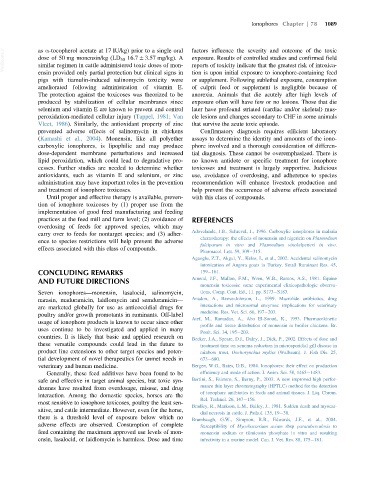Page 1157 - Veterinary Toxicology, Basic and Clinical Principles, 3rd Edition
P. 1157
Ionophores Chapter | 78 1089
VetBooks.ir as α-tocopherol acetate at 17 IU/kg) prior to a single oral factors influence the severity and outcome of the toxic
exposure. Results of controlled studies and confirmed field
dose of 50 mg monensin/kg (LD 50 16.7 6 3.57 mg/kg). A
reports of toxicity indicate that the greatest risk of intoxica-
similar regimen in cattle administered toxic doses of mon-
ensin provided only partial protection but clinical signs in tion is upon initial exposure to ionophore-containing feed
pigs with tiamulin-induced salinomycin toxicity were or supplement. Following sublethal exposure, consumption
ameliorated following administration of vitamin E. of culprit feed or supplement is negligible because of
The protection against the toxicoses was theorized to be anorexia. Animals that die acutely after high levels of
produced by stabilization of cellular membranes since exposure often will have few or no lesions. Those that die
selenium and vitamin E are known to prevent and control later have profound striated (cardiac and/or skeletal) mus-
peroxidation-mediated cellular injury (Tappel, 1981; Van cle lesions and changes secondary to CHF in some animals
Vleet, 1986). Similarly, the antioxidant property of zinc that survive the acute toxic episode.
prevented adverse effects of salinomycin in chickens Confirmatory diagnosis requires efficient laboratory
(Kamashi et al., 2004). Monensin, like all polyether assays to determine the identity and amounts of the iono-
carboxylic ionophores, is lipophilic and may produce phore involved and a thorough consideration of differen-
dose-dependent membrane perturbations and increased tial diagnosis. These cannot be overemphasized. There is
lipid peroxidation, which could lead to degradative pro- no known antidote or specific treatment for ionophore
cesses. Further studies are needed to determine whether toxicoses and treatment is largely supportive. Judicious
antioxidants, such as vitamin E and selenium, or zinc use, avoidance of overdosing, and adherence to species
administration may have important roles in the prevention recommendation will enhance livestock production and
and treatment of ionophore toxicoses. help prevent the occurrence of adverse effects associated
Until proper and effective therapy is available, preven- with this class of compounds.
tion of ionophore toxicoses by (1) proper use from the
implementation of good feed manufacturing and feeding
practices at the feed mill and farm level; (2) avoidance of REFERENCES
overdosing of feeds for approved species, which may
Adovelande, J.B., Schrevel, J., 1996. Carboxylic ionophores in malaria
carry over to feeds for nontarget species; and (3) adher-
chemotherapy: the effects of monensin and nigericin on Plasmodium
ence to species restrictions will help prevent the adverse
falciparum in vitro and Plasmodium vinckelpetteri in vivo.
effects associated with this class of compounds.
Pharmacol. Lett. 59, 309 315.
Agaoglu, Z.T., Akgul, Y., Keles, I., et al., 2002. Accidental salinomycin
intoxication of Angora goats in Turkey. Small Ruminant Res. 45,
CONCLUDING REMARKS 159 161.
AND FUTURE DIRECTIONS Amend, J.F., Mallon, F.M., Wren, W.B., Ramos, A.S., 1981. Equine
monensin toxicosis: some experimental clinicopathologic observa-
Seven ionophores—monensin, lasalocid, salinomycin, tions, Comp. Cont. Ed., 11. pp. S173 S183.
narasin, maduramicin, laidlomycin and semduramicin— Anadon, A., Reeve-Johnson, L., 1999. Macrolide antibiotics, drug
interactions and microsomal enzymes: implications for veterinary
are marketed globally for use as anticoccidial drugs for
medicine. Res. Vet. Sci. 66, 197 203.
poultry and/or growth promotants in ruminants. Off-label
Atef, M., Ramadan, A., Abo El-Sooud, K., 1993. Pharmacokinetic
usage of ionophore products is known to occur since other
profile and tissue distribution of monensin in broiler chickens. Br.
uses continue to be investigated and applied in many
Poult. Sci. 34, 195 203.
countries. It is likely that basic and applied research on
Becker, J.A., Speare, D.J., Daley, J., Dick, P., 2002. Effects of dose and
these versatile compounds could lead in the future to treatment time on xenoma reduction in microsporidial gill disease in
product line extensions to other target species and poten- rainbow trout, Onchorynchus mykiss (Walbaum). J. Fish Dis. 25,
tial development of novel therapeutics for unmet needs in 673 680.
veterinary and human medicine. Bergen, W.G., Bates, D.B., 1984. Ionophores: their effect on production
Generally, these feed additives have been found to be efficiency and mode of action. J. Anim. Sci. 58, 1465 1483.
safe and effective in target animal species, but toxic syn- Bertini, S., Feirrero, S., Berny, P., 2003. A new improved high perfor-
dromes have resulted from overdosage, misuse, and drug mance thin layer chromatography (HPTLC) method for the detection
of ionophore antibiotics in feeds and animal tissues. J. Liq. Chrom.
interaction. Among the domestic species, horses are the
Rel. Technol. 26, 147 156.
most sensitive to ionophore toxicoses, poultry the least sen-
Bradley, R., Markson, L.M., Bailey, J., 1981. Sudden death and myocar-
sitive, and cattle intermediate. However, even for the horse,
dial necrosis in cattle. J. Pathol. 135, 19 38.
there is a threshold level of exposure below which no Brumbaugh, G.W., Simpson, R.B., Edwards, J.F., et al., 2004.
adverse effects are observed. Consumption of complete Susceptibility of Mycobacterium avium sbsp paratuberculosis to
feed containing the maximum approved use levels of mon- monensin sodium or tilmicosin phosphate in vitro and resulting
ensin, lasalocid, or laidlomycin is harmless. Dose and time infectivity in a murine model. Can. J. Vet. Res. 88, 175 181.

